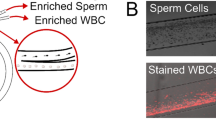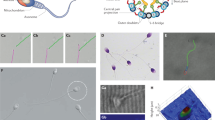Key Points
-
All men with obstructive azooospermia and many men with nonobstructive azoospermia will have sperm for biological pregnancies
-
Evidence is currently insufficient to recommend any specific sperm retrieval technique over another for either obstructive or nonobstructive azoospermia
-
The onus is on clinicians to develop efficient sperm retrieval techniques that maximize yield and minimize procedure numbers and morbidity
-
Obstructive azoospermia cases are associated with higher normal fertilization rates and clinical pregnancy rates compared with nonobstructive azoospermia cases
-
When fresh and frozen–thawed testicular sperm are compared, fertilization, clinical pregnancy, and ongoing clinical pregnancy rates are not different, but there is a significant decrease in implantation rates with frozen–thawed sperm
Abstract
Since the advent of intracytoplasmic sperm injection in 1992, sperm retrieval procedures have been routinely employed to treat male infertility owing to azoospermia. With obstructive azoospermia, sperm is potentially harvestable from the vas deferens, epididymis, and testicle using percutaneous and open sperm retrieval procedures that are relatively straightforward and reliable. In nonobstructive azoospermia, sperm is generally found only in the testicles and can often be difficult to retrieve. Several approaches aimed at maximizing sperm yield in this condition have been developed, but only 50% of men with nonobstructive azoospermia will have clinically usable sperm. Multibiopsy testicular sperm extraction (TESE), microdissection TESE, and fine-needle-aspiration map-guided TESE are three common methods currently employed to locate and retrieve sperm in these difficult cases. Other factors that influence the use of surgically retrieved sperm for assisted reproduction include differences in sperm DNA integrity, the expertise of the surgeon and the andrology laboratory, and the described differences in the viability of sperm from different anatomical sources after freezing and thawing.
This is a preview of subscription content, access via your institution
Access options
Subscribe to this journal
Receive 12 print issues and online access
$209.00 per year
only $17.42 per issue
Buy this article
- Purchase on Springer Link
- Instant access to full article PDF
Prices may be subject to local taxes which are calculated during checkout






Similar content being viewed by others
References
Jarow, J. P., Espeland, M. A. & Lipshultz, L. I. Evaluation of the azoospermic patient. J. Urol. 142, 62–65 (1989).
Palermo, G., Joris, H., Devroey, P. & Van Steirteghem, A. C. Pregnancies after intracytoplasmic injection of single spermatozoon into an oocyte. Lancet 340, 17–18 (1992).
Silber, S. J., Balmaceda, J., Borrero, C., Ord, T. & Asch, R. Pregnancy with sperm aspiration from the proximal head of the epididymis: a new treatment for congenital absence of the vas deferens. Fertil. Steril. 50, 525–528 (1988).
Proctor, M., Johnson, N., Van Peperstraten, A. M. & Philipson, G. Techniques for surgical retrieval of sperm prior to intra-cytoplasmic sperm injection (ICSI) for azoospermia. Cochrane Database of Systematic Reviews 2008, Issue 2. Art. No.: CD002807. http://dx.doi.org/10.1002/14651858.CD002807.pub3.
Friedler, S. et al. The outcome of intracytoplasmic injection of fresh and cryopreserved epididymal spermatozoa from patients with obstructive azoospermia--a comparative study. Hum. Reprod. 13, 1872–1877 (1998).
Sønksen, J. & Ohl, D. A. Penile vibratory stimulation and electroejaculation in the treatment of ejaculatory dysfunction. Int. J. Androl. 25, 324–332 (2002).
Tsai, M. C., Cheng, Y. S., Lin, T. Y., Yang, W. H. & Lin, Y. M. Clinical characteristics and reproductive outcomes in infertile men with testicular early and late maturation arrest. Urology 80, 826–832 (2012).
Qiu, Y., Wang, S. M., Yang, D. T. & Wang, L. G. Percutaneous vasal sperm aspiration and intrauterine insemination for infertile males with anejaculation. Fertil. Steril. 79, 618–620 (2003).
Saito, K. et al. Successful pregnancy with intrauterine insemination using vasal sperm retrieved by electric stimulation. Fertil. Steril. 77, 621–623 (2002).
Chiang, H., Liu, C., Tzeng, C. & Wei, H. No-scalpel vasal sperm aspiration and in vitro fertilization for the treatment of anejaculation. Urology 55, 918–921 (2000).
Bachtell, N. E., Conaghan, J. & Turek, P. J. The relative viability of human spermatozoa from the vas deferens, epididymis and testis before and after cryopreservation. Hum. Reprod. 14, 3048–3051 (1999).
Nudell, D. M. et al. The mini-micro-epididymal sperm aspiration for sperm retrieval: a study of urological outcomes. Hum. Reprod. 13, 1260–1265 (1998).
Craft, I. et al. Percutaneous epididymal sperm aspiration and intracytoplasmic sperm injection in the management of infertility due to obstructive azoospermia. Fertil. Steril. 63, 1038–1042 (1995).
Hutchon, S., Thornton, S., Hall, J. & Bishop, M. Frozen-thawed epididymal sperm is effective for intracytoplasmic sperm injection: implications for the urologist. Br. J. Urol. 81, 607–611 (1998).
Tournaye, H. et al. No differences in outcome after intracytoplasmic sperm injection with fresh or with frozen-thawed epididymal spermatozoa. Hum. Reprod. 14, 90–95 (1999).
Cayan, S. et al. A comparison of ICSI outcomes with fresh and cryopreserved epididymal spermatozoa from the same couples. Hum. Reprod. 16, 495–499 (2001).
Craft, I., Bennett, V. & Nicholson, N. Fertilising ability of testicular spermatozoa (letter). Lancet 342, 864 (1993).
Donoso, P., Tournaye, H. & Devroey, P. Which is the best sperm retrieval technique for non-obstructive azoospermia? A systematic review. Hum. Reprod. Update 13, 539–549 (2007).
Tuuri, T. et al. Testicular biopty gun needle biopsy in collecting spermatozoa for intracytoplasmic injection, cryopreservation and histology. Hum. Reprod. 14, 1274–1278 (1999).
Coburn, M. & Wheeler, T. M. in Infertility in the Male, 2nd edn (eds Lipshultz, L. I. & Howards, S. S.) 223–253 (Mosby Year Book, 1991).
Harrington, T. G., Schauer, D. & Gilbert, B. R. Percutaneous testis biopsy: an alternative to open testicular biopsy in the evaluation of the subfertile man. J. Urol. 156, 1647–1651 (1996).
Tournaye, H. et al. Are there any predictive factors for successful testicular sperm recovery in azoospermic patients? Hum. Reprod. 12, 80–86 (1997).
Kahraman, S. et al. Fertility with testicular sperm extraction and intracytoplasmic sperm injection in non-obstructive azoospermic men. Hum. Reprod. 11, 756–760 (1996).
Tournaye, H. et al. Correlation between testicular histology and outcome after intracytoplasmic sperm injection using testicular spermatozoa. Hum. Reprod. 11, 127–132 (1996).
Mulhall, J. P. et al. Presence of mature sperm in testicular parenchyma of men with nonobstructive azoospermia: prevalence and predictive factors. Urology 49, 91–95 (1997).
Schlegel, P. N. et al. Testicular sperm extraction with intracytoplasmic sperm injection for nonobstructive azoospermia. Urology 49, 435–440 (1997).
Turek, P. J., Ljung, B.-M., Cha, I. & Conaghan, J. Diagnostic findings from testis fine needle aspiration mapping in obstructed and nonobstructed azoospermic men. J. Urol. 163, 1709–1716 (2000).
Ostad, M., Liotta, D., Ye, Z. & Schlegel, P. N. Testicular sperm extraction for nonobstructive azoospermia: results of a multibiopsy approach with optimized tissue dispersion. Urology 52, 692–696 (1998).
Schlegel, P. N., Tanrikut, C. & Li, P. S. Microdissection testicular sperm extraction (TESE) in non-obstructive azoospermia. Fertil. Steril. 86, S519 (2006).
Amer, M., Ateyah, A., Hany, R. & Zohdy, W. Prospective comparative study between microsurgical and conventional testicular sperm extraction in non-obstructive azoospermia: follow-up by serial ultrasound examinations. Hum. Reprod. 15, 653–656 (2000).
Okada, H. et al. Conventional versus microdissection testicular sperm extraction for nonobstructive azoospermia. J. Urol. 168, 1063–1067 (2002).
Silber, S. J. Microsurgical TESE and the distribution of spermatogenesis in non-obstructive azoospermia. Hum. Reprod. 15, 2278–2284 (2000).
Takada, S. et al. Androgen decline in patients with nonobstructive azoospermia after microdissection testicular sperm extraction. Urology 72, 114–118 (2008).
Ishikawa, T., Yamaguchi, K., Chiba, K., Takenaka, A. & Fujisawa, M. Serum hormones in patients with nonobstructive azoospermia after microdissection testicular sperm extraction. J. Urol. 182, 1495–1499 (2009).
Everaert, K. et al. Long term effects of micro-surgical testicular sperm extraction on androgen status in patients with non obstructive azoospermia. BMC Urol. 6, 9–12 (2006).
Dabaja, A. A. & Schlegel, P. N. Microdissection testicular sperm extraction: an update. Asian J. Androl. 15, 35–39 (2013).
Turek, P. J., Cha, I. & Ljung, B.-M. Systematic fine-needle aspiration of the testis: correlation to biopsy and results of organ “mapping” for mature sperm in azoospermic men. Urology 49, 743–748 (1997).
Beliveau, M. E. & Turek, P. J. The value of testicular 'mapping' in men with non-obstructive azoospermia. Asian J. Androl. 13, 225–230 (2011).
Ljung, B.-M. in Techniques of Aspiration and Smear Preparation (eds Koss, L. G., Woyke, S. & Olszewski, W.) 12–34 (Igaku-Shoin, 1992).
Jad, A. M. & Turek, P. J. Experience with testis FNA mapping and microdissection (M & M) in difficult nonobstructive azoospermia cases. Fertil. Steril. 78, S71 (2002).
Gouletsou, P. G., Galatos, A. D., Leontides, L. S. & Sideri, A. I. Impact of fine or large needle aspiration on the dog's testis: in vitro ultrasonographic, bacteriological, gross anatomy and histological assessment. Theriogenology 74, 1604–1614 (2010).
Dahlbom, M., Mäkinen, A. & Suominen, J. Testicular fine needle aspiration cytology as a diagnostic tool in dog infertility. J. Small Anim. Pract. 38, 506–512 (1997).
Nicopoullos, J. D. et al. Use of surgical sperm retrieval in azoospermic men: a meta-analysis. Fertil. Steril. 82, 691–701 (2004).
Morris, D. S., Dunn, R. L., Schuster, T. G., Ohl, D. A. & Smith, G. D. Ideal culture time for improvement in sperm motility from testicular sperm aspirates of men with azoospermia. J. Urol. 178, 2087–2091 (2007).
Bungum, M. et al. Sperm DNA integrity assessment in prediction of assisted reproduction technology outcome. Hum. Reprod. 22, 174–179 (2007).
Natali, A. & Turek, P. J. An assessment of new sperm tests for male infertility. Urology 77, 1027–1034 (2011).
Tesarik, J. et al. Caspase-dependent and -independent DNA fragmentation in Sertoli and germ cells from men with primary testicular failure: relationship with histological diagnosis. Hum. Reprod. 19, 254–261 (2004).
Celik-Ozenci, C. et al. Sperm selection for ICSI: shape properties do not predict the absence or presence of numerical chromosomal aberrations. Hum. Reprod. 19, 2052–2059 (2004).
Steele, E. K., McClure, N. & Lewis, S. E. M. Comparison of the effects of two methods of cryopreservation on testicular sperm DNA. Fertil. Steril. 74, 450–453 (2000).
Greco, E. et al. Efficient treatment of infertility due to sperm DNA damage by ICSI with testicular spermatozoa. Hum. Reprod. 20, 226–230 (2005).
Moskovtsev, S. I. et al. A comparison of ejaculated and testicular spermatozoa aneuploidy rates in patients with high sperm DNA damage. Syst. Biol. Reprod. Med. 58, 142–148 (2012).
Bunge, R. G. & Sherman, J. K. Fertilizing capacity of frozen human spermatozoa. Nature 172, 767–768 (1953).
Turek, P. J. in Reproductive Endocrinology and Infertility: Integrating Modern Clinical and Laboratory Practice (eds Carrell, D. T. & Petersen, C. W.) 453–465 (Springer, 2010).
Author information
Authors and Affiliations
Contributions
Both authors researched the data for the article, provided a substantial contribution to discussions of the content and contributed to writing the article and to review and/or editing of the manuscript before submission.
Corresponding author
Ethics declarations
Competing interests
The authors declare no competing financial interests.
Rights and permissions
About this article
Cite this article
Shin, D., Turek, P. Sperm retrieval techniques. Nat Rev Urol 10, 723–730 (2013). https://doi.org/10.1038/nrurol.2013.262
Published:
Issue Date:
DOI: https://doi.org/10.1038/nrurol.2013.262
This article is cited by
-
Testosterone levels among non-obstructive azoospermic patients 2 years after failed bilateral microdissection testicular sperm extraction: a nested case-cohort study
Journal of Assisted Reproduction and Genetics (2022)
-
Omics in Seminal Plasma: An Effective Strategy for Predicting Sperm Retrieval Outcome in Non-obstructive Azoospermia
Molecular Diagnosis & Therapy (2021)
-
Testikuläre Spermienextraktion bei männlicher Infertilität
Der Urologe (2021)
-
Hypogonadism Following Sperm Extraction: a Scoping Review of the Current Literature
Current Sexual Health Reports (2021)
-
Hormonal markers as noninvasive predictors of sperm retrieval in non-obstructive azoospermia
Journal of Assisted Reproduction and Genetics (2021)



